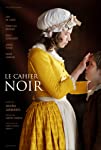Eye For Film >> Movies >> The Black Book Of Father Dinis (2018) Film Review
The Black Book Of Father Dinis
Reviewed by: Jennie Kermode

When we first meet Laura (Lou de Laâge), who is also our narrator, she is a servant in attendance at a birth. Though the mother was once a fine lady, the circumstances of her pregnancy have seen her fall from grace. It's Laura who ends up caring for the boy, young Sebastian, and Laura who is still with him years later when the audience is made privy to the secret that his father was a clergyman.The boy's story is written down in the black book of the title, he and his nurse taken in by a nobleman, but without respected names of their own, they have no guarantee of security, no stability in their lives. When circumstances tear them apart, Laura devotes herself to getting back to the boy, in the process uncovering secrets not just about his life but abut her own.
Offstage but influencing the action throughout is the slow process of upheaval that led to the French Revolution and, subsequently, the rise of Napoleon (who briefly appears in a cameo, played by Grégoire Leprince-Ringuet). This adds a twist to the conventional narratives of the time because for all that the aristocrats abuse their power, viewers will be aware that this is a period when it's better to be poor. Other aspects of European politics are woven int the story and although those familiar with the period will appreciate the fact that the film just gets on with it, others may find it confusing and wish there were a bit more by way of explanation.

The novel on which this is based, Livro Negro de Padre Dinis, was an early work for Camilo Castelo Branco, when he was interested primarily in storytelling with rather less focus on form. It retains that romantic yet bittersweet quality characteristic of his work, but unfortunately the wit vital to maintaining its energy has been lost in the translation to the screen. As we move from one scenario to another, with little opportunity to get to know the supporting characters, the emotional pull of the piece is lost. We feel for Laura and de Laâge does her best but it's still a slender thread on which to hang almost two hours of film.
Of course, many viewers are attracted to historical dramas less by story than by setting, and in the latter regard, this one acquits itself much better. Although it uses relatively few locations they're attractively shot, in a style which, curiously, owes more to the work of Dutch artists of the period than to that of the French. The mingling of characters from different classes allows Rute Correia a measure of creative freedom when it comes to costume design, and the production design is impressive overall.
A longer version of this film has been released as a mini series, and despite the good production work it is in many ways better suited to the small screen. Seen as a single piece, it feels slow and unwieldy. Fans of the source material are likely to enjoy it, however, and with a different angle from most period works, it will appeal to genre lovers.
Reviewed on: 05 Dec 2020

















